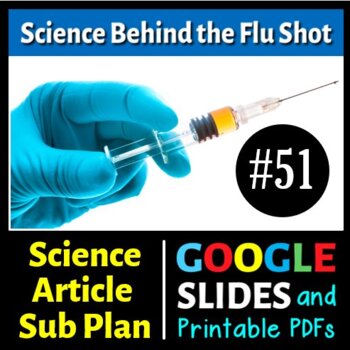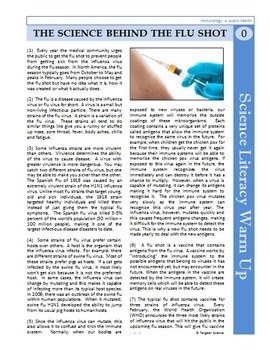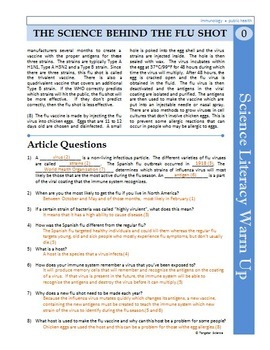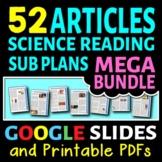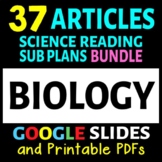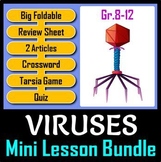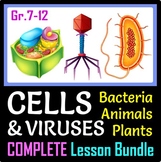Science of the Flu Shot / Vaccines: Science Article #51 - (Google Slides & PDFs)
- Zip
- Google Apps™

Also included in
- Updated to Include Distance Learning Options. Each article sub plan comes in two versions with full answer keys: 1) Easily printable PDFs, as well as 2) Google Slides. Students can type in their answers directly in the Google Slides for paperless classrooms / distance learning. Don't fear, getPrice $99.50Original Price $175.00Save $75.50
- Updated to Include a Distance Learning Option. This science article / sub plan comes in two versions with full answer keys: 1) Easily printable PDFs, as well as 2) Google Slides. Students can type in their answers directly in the Google Slides.This is perfect for no-prep sub days while also being grPrice $79.99Original Price $122.50Save $42.51
- These SEVEN RESOURCES will help you deliver a fantastic and engaging lesson on viral structure (bacteriophage and retrovirus) and viral replication (lytic cycle and lysogenic cycle). In this bundle, you will save 25% OFF of all the individual resources. Click the PREVIEW for a closer look at the itPrice $17.50Original Price $23.97Save $6.47
- These SIXTEEN RESOURCES will help you deliver a fantastic and engaging lesson on viruses (viral structure and replication) and bacteria (prokaryotic cells). In this bundle, you will save 35% OFF of all the individual resources. Click the PREVIEW for a closer look at the items in this bundle.*******Price $41.99Original Price $64.42Save $22.43
- Bundle DescriptionThese THIRTY-ONE RESOURCES will help you deliver a fantastic and engaging lesson on cells and viruses. In this bundle, you will save over 45% OFF of all the individual resources. Below is a description of all the resources (19 of these resources also have Google Slide options for pPrice $73.99Original Price $135.82Save $61.83
Description
This science article / sub plan comes in two versions (with answer key): 1) easily printable PDFs, as well as 2) Google Slides for distance learning. Students can type in their answers directly in the Google Slides. This resource spans two pages in total with 1 and 1/3 pages of article and 2/3 pages of questions. It is information rich and written to engage even reluctant readers. The two page format makes it economical for printing and provides a length that students willingly read and complete.
***********************************************************************
ARTICLE TOPIC: In this particular article, students will learn about viruses, the types of viruses that cause the flu, how the immune system detects and remembers viruses, how vaccines like the flu shot work and how the flu shot vaccine is manufactured.
***********************************************************************
✿ INTERESTED IN MORE ARTICLES? Check these out:
► SCIENCE Articles MEGA Bundle - 52 Articles for 44% OFF.
► BIOLOGY Articles Bundle - 35 Articles for 32% OFF.
► SCIENCE Articles Vol. 1 Bundle - 10 Articles for 27% OFF.
► SCIENCE Articles Vol. 2 Bundle - 10 Articles for 27% OFF.
► SCIENCE Articles Vol. 3 Bundle - 10 Articles for 27% OFF.
► SCIENCE Articles Vol. 4 Bundle - 10 Articles for 27% OFF.
► SCIENCE Articles Vol. 5 Bundle - 10 Articles for 27% OFF.
► Great Minds in Science Bundle - 19 Articles for 44% OFF.
***********************************************************************
NUMEROUS USES:
The great thing about this article is that it can be used for a variety of assignments if not used for a sub plan. There is a call for increased science literacy in classes, and a push to make science relevant to students. Engaging science articles are a good way to meet these needs.
1) No prep sub plans that are easy to hand out and collect.
2) In school suspension plan.
3) Independent work for early finishers.
4) No prep extra credit assignment.
5) Homework assignment.
6) Warm up work for the beginning of class.
7) Assign at the beginning of the week and take up at the end.
***********************************************************************
SCIENCE READING ARTICLES (All can be found in the MEGA BUNDLE of 50 Articles):
Article #1 – Why We Love and Hate Spicy Foods
Students will learn about the science behind the feeling of spiciness, what chemical compound creates this sensation, the way spiciness is measured, why the desire to eat spicy foods evolved and how to cure the pain of overly spicy food.
Article #2 – Tears Tears Everywhere
Students will learn about the differences in the three types of tears humans produce, the composition of these tears and their different purposes.
Article #3 – Beyond the Appendix: Vestigial Structures
Students will learn about vestigial structures and about several different examples of human vestigial structures (wisdom teeth, ear muscles, "third" eyelid, tailbone and appendix) as well as some vestigial body responses like piloerection, otherwise known as "goosebumps".
Article #4 – Dung Beetles: Where Did All the Poo Go?
Students will learn about the interesting habits, diets and behaviors of the dung beetle. They will also learn about why dung beetles are important to ecosystems.
Article #5 – Cancer Sniffing Dogs
Students will learn how a sample of someone's breath can contain compounds released from cancer cells, how sensitive dogs are to scents, how dogs are trained to detect cancer compounds in samples of patients' breath and what other things a dog's sense of smell can be used for.
Article #6 – Hyponatremia: Death by Water Intoxication
Students will learn how water intoxication occurs as well as the symptoms of hyponatremia. They will also learn about who is most at risk for this condition and they will be given examples of people who have suffered from hyponatremia.
Article #7 – Body Fat: The Good, The Bad and the Ugly Truth
Students will learn about the different types of fat in the body, their functions and the issues that can arise when fat content in the body becomes imbalanced.
Article #8 – Photosynthetic Animals
Students will learn about two animals (green sea slug and yellow spotted salamander) that can photosynthesize due to symbiotic relationships with algae.
Article #9 – Diamonds, the Truth Behind the Bling
Students will learn about the properties of a diamond and what makes it different from graphite, different methods of creating synthetic diamonds, and what applications these synthetic diamonds have. They will also learn about a planet in our Milky Way galaxy made up of at least one third diamond.
Article #10 – Facebook Blues: Is Facebook Making You Unhappy?
Students will learn about studies that show that using Facebook and other social media correlate with decreased feelings of well-being. Facebook addiction is also discussed along with a the Bergen Facebook Addiction Scale. The scale has been provided for students to diagnose their own Facebook dependency. A great class discussion can ensue from this.
Article #11 – The Making of Human Hermaphrodites
Students will learn about human hermaphrodites, the etymology of the word hermaphrodite, the two major causes of human hermaphrodism (46XX/46XY chimeras, the SRY gene) and other organisms that are hermaphroditic.
Article #12 – Are Bed Bugs Keeping You Awake?
Students will learn about beg bugs, their physical and behavioral characteristics, how they reproduce, their effects on human hosts, why cases of infestation in developed countries has risen in the last few decades and what methods do and don't work in attempts to eradicate them.
Article #13 – Miraculous Medical Maggots
Students will learn about how maggot debridement therapy (MDT) is used to heal wounds and stave off infection, why the common green bottle fly larva is the maggot of choice, what type of wounds are best suited to MDT and the rise, fall and re-emergence of MDT as a popular medical treatment.
Article #14 – How Anabolic Steroids Work
Students will learn about how steroids build muscle by building proteins, preventing the breakdown of proteins and by activating satellite cells that help produce more and bigger muscle cells. Side effects of anabolic steroid use is also discussed.
Article #15 – The Science of Sleep
Students will learn the differences between REM and nonREM sleep, how much sleep is needed for individuals, why sleep is important, what happens when someone experiences sleep deprivation and insomnia and how other mammals exhibit different sleep patterns and habits when compared to us.
Article #16 – Parasites Create Zombie Snails
Students will learn about the L. paradoxum parasite that infects snails. The parasite takes over the snail's body and mind to turn it into an organism that will attract birds, the parasite's second host. This gruesome tale will enthrall your students and teach them about animal adaptations and parasitism at the same time.
Article #17 – Breathing and Peeing in Space
Students will learn about the challenges of supporting human life in a space craft. The focus will be on the technologies that are used to constantly supply the crew with oxygen and that help get rid of liquid and solid waste in a microgravity environment.
Article #18 – Is it Ironman? No, it's Alloyman!
Students will learn about alloys, how they are made, how steel and stainless steel are made and about Nitinol, the amazing superelastic alloy that makes up Ironman's suit.
Article #19 – Immortal Cancer Cells
Students will learn about Henrietta Lacks and how cancer cells from her body, called HeLa cells, have been dividing for over six decades to produce immortal cell lines that have been used in medical and commercial research all over the world. Students will learn about the limits of cell division and how cancer cells circumvent these limits.
Students will learn about soil, what it is made of, why it is so important to our survival and what factors are causing soil to be endangered throughout our planet. A great article for discussing ecological and environmental issues.
Article #21 – Sex Changing Fish
Students will learn about how some fish are able to change sex from male to female or from female to male. They will find out what type of reproductive advantages this gives the fish and what conditions trigger sex changes.
Article #22 – Fecal Transplants
Students will learn about how fecal microbiota transplants help treat intestinal diseases like C. diff infections. They will learn how the fecal transplant helps get rid of the infection, how fecal samples are obtained and how they are administered into the body.
Article #23 – Human Cyborgs vs. Bionic Humans
Students will learn about the differences between a bionic implant and a cybernetic implant and how the two function differently and can achieve different results. The last part of the article turns to the idea of using human cyborgs in the military and can lead into a class discussion about the bioethics of this and other cybernetic applications.
Article #24 – Black Holes Explained
Students will learn about black holes and how they are related to the space-time continuum and gravity. An analogy is used for easy understanding. The event horizon and singularity is also explained as well as the classification of three types of black holes.
Article #25 – The Science and Evolution of Human Skin Color
Students will learn about the pigment melanin, its function and how the skin produces and distributes this substance to produce different levels of skin pigmentation. They will also learn about albinism and about how changing environmental conditions and determine the level of skin pigmentation in evolving populations. Also discussed is the reason why women, in general, are less pigmented then men.
Article #26 – Tanning, UV Radiation and Skin Cancer
Students will learn about why tanning has become popular, the differences between UVA and UVB and how both cause a different type of tanning response in the skin and health consequences of each, and finally, students will learn about skin cancer with a focus on melanoma and risk factors for developing skin cancer.
Article #27 – Lobotomies: Who Needs All that Brain?
Students will learn about lobotomies, why they were used, how they were performed, the people who helped develop the procedure (António Egas Moniz, and Walter Freeman), the effect lobotomies had on patients and why the technique is no longer widely used to treat mental illnesses.
Article #28 – The Importance of Bees
Students will learn how pollination occurs, how the honeybee is specialized to collect pollen, why the honeybee is used by beekeepers over other pollinators and how critical bees are for global food production.
Article #29 – Antibiotics: Penicillin and Beyond
Students will learn about bactericidal vs. bacteriostatic antibiotics, narrow vs. broad spectrum antibiotics, what antibiotics are effective in treating, how penicillin was discovered by Alexander Fleming and how the misuse, overprescription and use of subtherapeutic antibiotics in livestock feed has contributed to the growing antibiotic resistance seen in bacteria. How antibiotic resistance develops is also discussed.
Article #30 – Addicted to Sugar
Students will learn about the health impacts of sugar, research showing that sugar can be more addictive than cocaine or heroine, the effect of sugar on the brain, how available sugar was to our ancestors, the effects of high-fructose corn syrup, an example of how hidden added sugars can be found in "healthy" meals and how to read food labels appropriately so that the sugar content can be better understood.
Article #31 – Food Designed for Space
Students will learn about the challenges of designing food for astronauts, the requirements that space food must meet (like taking up very little space and having a long shelf-life at room temperatures), the different categories of space foods, how different equipment must be made for eating a meal in microgravity environments, and why food in space doesn't taste as good as it would on Earth.
Article #32 – Is Life Better Without Pain?
Students will learn about the usefulness of pain to survival and about CIPA (congenital insensitivity to pain with anhidrosis). They will learn about the difficulties people with CIPA face because they cannot feel pain, the different types of nociceptors (pain neurons) that exist in humans, how mutations in a gene destroys nociceptors in people with CIPA, the concerns parents need to have if their child has CIPA and how CIPA is genetically inherited.
Article #33 – Blood Doping: More Blood, More Medals
Students will learn about why athletes blood dope, the performance enhancement effects of blood doping, blood doping techniques like drugs that stimulate red blood cell production and blood transfusions that increase red blood cell counts immediately. As well they will learn about the effects of high altitude training on red blood cell production (which is a legal method of increasing red blood cell count) and about the World Anti-Drug Doping Agency's use of athlete biological passports to detect cheating.
Article #34 – Hello Gastric Bypass, Goodbye Stomach
Students will learn about morbid obesity and the two main types of bariatric procedures (restrictive methods and malabsorptive methods) that are used to treat this condition. Gastric banding and gastric bypass are specifically examined. This is a great extension activity for classes studying the digestive system or nutrition.
Article #35 – An Athlete's Perfect Twitch
Students will learn about slow twitch and fast twitch muscle fibers, how they create and use energy differently, how they respond to training and which types of sport each muscle fiber is best suited to helping an athlete excel at. For example, a greater ratio of slow twitch to fast twitch muscles fibers will help an athlete excel at endurance sports like marathons and long distance cycling.
Article #36 – The Curious Case of Caffeine
Students will learn about the mental and physical effects of caffeine on the body, how caffeine acts on the brain to increase neuronal activity which causes alertness, how caffeine triggers the fight or flight reflex and how tolerance and addiction occur with regular caffeine intake.
Article #37 – The Chemistry of Fireworks Students will learn about the various components of a firework and their role in the function of the firework. They will examine the composition of the gun powder which explodes to launch the firework into the air and examine the "stars" which are the metal salts that burn with various different colors when they are ignited within the firework.
Article #38 – Climate Change and Pizzly Bears
Students will learn about how climate change is warming the Arctic and threatening the habitat of the polar bear. As this happens, it makes way for grizzly bear territory to expand further north which increases the interaction between the two species, with possible mating opportunities. Beyond speculation, two real cases of pizzly bear offspring in the wild (as confirmed by genetic testing) is discussed along with the possibility of other Arctic hybrids.
Article #39 – The Science of Self-Control
Students will learn about the famous Marshmallow Experiments done in the 1970s. These experiments demonstrate a strong correlation between the ability to exert self-control in children and their later success as adults. Students will also learn about how habit retraining can help overcome the negative behaviors that seem to stem from the lack of self-control.
Article #40 – The Truth Behind Bottled Water
Students will learn about how bottled water companies have convinced us to buy bottled water and the environmental impact of creating so much plastic water bottle waste. They will discover that PET (polyethylene terephthalate) is the most common type of plastic beverage container and will read about PET's properties, how it is it is recycled (and down-cycled) and how it eventually makes its way into our landfills and oceans.
Article #41 – Natural Selection Explained
Students will learn about natural selection using specific examples. One example is the change in color of the peppered moth from its light colored form to its dark colored form. The other example is the dramatic change in the size of the giant insects of the prehistoric era to the much smaller ones we have today. Artificial selection is also discussed in contrast to natural selection.
Article #42 – The Evolution of Pretty Boys
Students will learn about sexual selection and how female mate choice has strongly influenced the physical and behavioral traits that have evolved in males. This is especially seen in bird populations like peafowls and birds of paradise where the males exhibit extraordinarily beautiful plumage and intricate and interesting courtship behaviors. Ronald Fishers "Fisherian runaway" hypothesis as well as other interesting evolutionary theories behind sexual selection are examined. Male competition using the example of elephant seal bulls is also discussed.
Article #43 – Living in Space Harms Your Body
Students will learn about the downsides of living in space. Time spent in weightless conditions lead to serious bone loss and almost immediate and severe muscle atrophy. It also leads to cardiac muscle weakening as well as damages the optic nerves. These and the other fascinating negative effects of space living are discussed.
Article #44 – Fossil Fuels Uncovered
Students will learn about fossil fuels, in particular: oil, natural gas and coal. They will learn about the conditions under which fossil fuels are created and what turns some organic remains into oil and natural gas, while other remains form coal. They will also learn about the negative environmental consequences of fossil fuel use (e.g. climate change) and a movement to "Keep it in the ground".
Article #45 – Love and Cupid's Chemicals
Students will learn about the three scientifically recognized components of love: sex drive (libido), attraction and attachment. They will learn about what characterizes each stage and the major hormones involved in each stage. Some interesting studies are also discussed which examine how lowering certain hormones affect libido and attachment. This is a great article to use around Valentine's Day if you don't need to use it for a sub plan.
Article #46 – The Zika Virus Emerges
Students will learn about the Zika virus, where it first came from, where it's spreading to, how it is transmitted, and the symptoms it produces. Also discussed is the link between Zika and microcephaly (babies born with small heads) which is the major concern with the Zika outbreak, and the potential for Zika to turn into a pandemic.
Article #47 – Fracking Facts and Fears
Students will learn about extracting shale oil and gas through the process of fracking. Conventional drilling versus fracking is compared. Horizontal drilling and the chemicals used in the fracking process are explained. The various concerns and risks surrounding fracking are discussed as well as the stance different countries have taken on the fracking issue.
Article #48 – The Science of Tattoos
Students will learn about the science of tattoos. They will learn how tattoos are applied, what makes them permanent, and how the immune system causes tattoos to fade. They will also read about how the immune system aids the laser tattoo removal procedure to help get rid of tattoo ink. The safety of tattoo inks is also discussed along with how they can be affected by MRIs.
Article #49 – Mitochondrial Eve
Students will learn about mitochondrial DNA and Mitochondrial Eve. Mitochondrial Eve is the most recent common ancestor of all modern anatomical humans. Students will read about how mitochondrial DNA has helped geneticists discover Mitochondrial Eve, about the research behind her discovery and about the implications of this research on the evolutionary origins of humans. Also discussed is how this data supports the Out of Africa theory of human migration and expansion.
Article #50 – Stem Cell Science
Students will learn about stem cells and stem cell research. They will read about the difference between embryonic stem cells and adult stem cells as well as understand the controversy over stem cell research. They will examine the difference between totipotent, pluripotent and multipotent stem cells. Lastly, they will read about the exciting advances in stem cell research opened up by the advent of IPSCs (induced pluripotent stem cells) which helps bypass many of the ethical issues in stem cell research.
***********************************************************************
GREAT MINDS IN SCIENCE ARTICLES (All can be found in the Bundle of 18 Articles):
Article highlights include: his mother's tenacity which allowed him to attend university where he faced various obstacles to rise to the top of his class; his concerns for the development of science education in Russia which compels him to write Russian language textbooks; his certainty that science can be standardized by understanding a pattern that exists among elements; his journey to decipher this pattern; his development of the periodic table and having element 101 (Mendelevium) named after him.
Article highlights include: his poverty growing up; his only way to obtain an education was to become a monk which he did reluctantly; he failed twice at obtaining a certification for teaching but the monastery allowed him to teach despite this; the beginning of his studies into inheritance and heredity; the fortuitous choice of garden peas for his studies and the development of his Mendel's laws of inheritance.
Article highlights include: his numerous failed attempts at studies and his father's disappointment in him; his eventual success at studies into the natural world; his voyage on the HMS Beagle; his return to England to scientific acclaim and respect; ideas that influenced his development of his theory of evolution by natural section (Lyell, Malthus etc.) and the need to publish his findings because Alfred Russel Wallace began coming up with the same theory of evolution by natural selection.
Article highlights include: her brilliance at scientific studies as a child; her inability to continue her studies in Poland because universities there didn't accept women; her struggles to make money so that she could attend university in France at the age of 24; her love of Pierre Curie and their work together on radioactivity; her discovery of polonium and radium; her two Nobel Prizes; her significant but largely unrecognized contributions to the war effort in WWI and her death from aplastic anemia due to radiation exposure.
Article highlights include: explanation of the European Renaissance; Galileo convincing his father he should become a mathematician and physicist instead of a doctor, his invention of many interesting devices, observations of Kepler's supernova, his development of the telescope and its uses in his research, his discovery of the four largest moons of Jupiter, his discovery of the shadows of Saturn that supported the heliocentric model over the geocentric model, his persecution by the Inquisition of the Catholic Church due to his support of the heliocentric model, his recanting upon threat of torture and his imprisonment until death.
Article highlights include: details of his difficulties with authority and school while growing up; his amazingly productive 1905 year when he came up with and published four groundbreaking ideas (including e=mc2 and the special theory of relativity); an application of the theory of relativity; an explanation of the significance of e=mc2, his abandonment of Germany during the rise of Adolf Hitler's Third Reich, his emigration to America, his contribution to the Manhattan Project's development of nuclear weapons and his great regret for contributing to the nuclear bombings of Hiroshima and Nagasaki.
Article #7 - Rosalind Franklin
Article highlights include: Franklin's achievements as a child; her research into the structure of coal which earned her a PhD; her apprenticeship for learning about X-ray diffraction; her appointment to work at King's College to help discover the structure of DNA; the tensions and hostilities with her research partner Maurice Wilkins; her success at obtaining excellent X-ray diffraction images of two forms of DNA; Wilkin's release of these images to a rival team (James Watson and Francis Crick) of researchers without telling Franklin; Franklin's research into the structure of plant viruses; Franklin's early death due to ovarian cancer at the age of 37 and the controversy over her not being acknowledged by the Nobel Prize committee.
Article highlights include: Linnaeus' early and intense passion for plants; his failure to do well in school; how he became a lecturer of botany at a university at the tender age of 23; his intrepid expeditions to find new species of plants and animals; his desire to change the way species were named and his development of binomial nomenclature and his own system of classification; his great popularity as a teacher of botany; his devoted students who he sent off to remote areas of the world to collect new plant and animal specimens (7 of whom died during the task) and his controversial grouping of humans with primates.
Article #9 - Alexander Fleming
Article highlights include: Fleming's early achievements as a child; his aspirations to become a surgeon; his attainment of a medical degree; his shift in focus to studying bacteria instead of medicine; his time spent in battlefield hospitals in World War I where he promoted a better way to treat deep wounds since the method currently used was killing many of the soldiers; his discovery of lysozymes in bodily secretions which could kill bacteria and his accidental discovery of penicillin due to the contamination of bacterial samples by mold.
Article highlights include: Carson's duel passions for writing and nature as a child; her academic achievements; taking a job with the U.S. Bureau of Fisheries to help support her family; her budding and acclaimed career as a writer; her concern for the widespread use of DDT and other pesticides; her need to make the public aware of the dangers of pesticides by writing a groundbreaking book called Silent Spring; her battle with intestinal and breast cancer during the four years it took to complete the book and how Silent Spring inspired a new young generation of environmental activists.
Article highlights include: Tesla's academic highs and lows where he demonstrated both an exceptional mind as well as a severe gambling addiction; his prolific ability to create useful inventions; Tesla's employment and falling out with Thomas Edison; the battle between Edison's DC current system and Tesla's AC current system; the destruction of hundreds of Tesla's plans for inventions when his laboratory caught fire and his futuristic ideas for later inventions.
Article highlights include: Bohr's parents who pushed him towards intellectual excellence; Bohr's ambition, resourcefulness and ability to rise above the expected; his habit of correcting everyone around him who he thought was wrong and how this got him into both fistfights as well as created friction with his colleagues and his breakthrough discovery that electrons were found in distinct pathways (orbitals) around the nucleus of an atom and that these electrons exhibited discrete energy states.
Article highlights include: how Hubble's father pushed him to become a lawyer when he really wanted to become an astronomer; how Hubble gave up law and pursued his dream of astronomy after his father's death; how he was considered more of a jock and athlete than an intellectual at school; how he made the big discovery that the universe was larger than just the Milky Way Galaxy when he figured out that he was analyzing pulsating stars that must be located outside of our galaxy (this debunked the idea of a single-galaxy universe and created a sea-change in how astronomy was researched); how the Hubble Space Telescope (HST) is named after him and what the HST does and how and why he was never awarded a Nobel Prize.
Article highlights include: Pasteur's schooling which was riddled with poor academic performances and failed exams; his eventual rise to a professor of chemistry; his strict standards and discipline which won him few friends but served him well as a scientist; his fermentation experiments which disproved the theory of spontaneous generation and which showed that microbes could cause food spoilage; his development of and uses for pasteurization; Pasteur's revolutionary proposal of the "germ theory" of disease; how germ theory had an immensely positive effect on the field of medicine by causing doctors to begin to wash their hands and sterilize their medical equipment and finally, Pasteur's development of the first vaccines.
...and 5 more scientists.... which I cannot fully describe due to reaching the text limit in this description space. These include:
Article #15 - George Washington Carver
FREE BONUS Article #19 - Benjamin Franklin
***********************************************************************
Copyright © 2016 Anh-Thi Tang (Tangstar Science)
All rights reserved by author.

